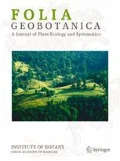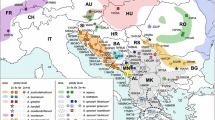Abstract
A multivariate analysis has been performed in order to study the polymorphisms of the three species ofPotentilla sect.Recta (Th. Wolf)Juzepchuk represented in the Iberian Peninsula:P. asturica Rothm.,P. hirta L. andP. recta L. The variability of 20 characters (quantitative, binary and qualitative) has been evaluated in 76 collections mostly from the Iberian Peninsula and from other European territories, but also from North America, and North Africa. The analyses performed provide support for the recognition of the three species. The most discriminant among the quantitative characters is the width of the long trichomes on the stem, and then the width of the long trichomes on the leaves and the maximum length of the long trichomes. The interval of number of carpels, presence or absence of short eglandular trichomes and the abundance of long eglandular trichomes (>3 mm) are the most discriminant ones among the qualitative ones. The taxonomical position ofP. asturica, which has been previously subordinated as a subspecies within the other two taxa, is discussed. Our results support a good delimitation of this taxon which, on the basis of the morphological characters studied by us, seems to be morphologically more close toP. hirta than toP. recta, but differs significantly from both. A key to the three species is provided.
Similar content being viewed by others
References
Ball P.W., Pawłowski B. &Walters S.M. (1968):Potentilla L. In:Tutin T.G. et al. (eds.),Flora europaea 2, Cambridge Univ. Press, Cambridge, pp. 36–47.
Delgado L., Gallego F. &Rico E. (2000): Karyosystematic study ofPotentilla L. subgen.Potentilla (Rosaceae) in the Iberian Peninsula.Bot. J. Linn. Soc. 132: 263–280.
Eriksen B. (1997): Morphometric analysis of Alaskan members of the genusPotentilla sect.Niveae (Rosaceae).Nord. J. Bot. 17: 621–630.
Eriksson T., Donoghue M.J. &Hibbs M.S. (1998): Phylogenetic analysis ofPotentilla using DNA sequences of nuclear ribosomal internal transcribed spacers (ITS), and implications for the classification ofRosoideae (Rosaceae).Pl. Syst. Evol. 211: 155–179.
Fernández González F. (1986): Datos florísticos sobre el valle del Paular (Sierra de Guadarrama). In:Rivas Martínez S. (ed.), De plantis carpetanis notulae systematicae II,Lazaroa 8:119–122.
Guillén A. &Rico E. (1998):Potentilla L. In:Muñoz Garmendia F. &Navarro C. (eds.),Flora iberica 6, Servicio de publicaciones del C.S.I.C., Madrid, pp. 96–140.
Holmgren P.K., Holmgren N.H. & Barnet L.C. (1990): Index herbariorum. Part I. The Herbaria of the World. Ed. 8.Regnum Veg. 120.
Juzepchuk S. (1941):Potentilla L. In:Komarov V.L. (ed.),Flora SSSR 10 (Flora of the USSR), Izdatel’stvo Akademii Nauk SSSR, Moskva, Leningrad, pp. 78–223.
Laínz M. (1964): Aportaciones al conocimiento de la flora cántabro-astur, VIII.Bol. Inst. Estud. Asturianos, ser. C., 10: 173–218.
Leht M. (1996): Cladistic analysis of the data published in “Monographie der GattungPotentilla” by T. Wolf.Proc. Estonian Acad. Sci. Biol. 45: 171–180.
Leht M. &Paal J. (1998a): Variation ofPotentilla erecta (Rosaceae) in Estonia.Ann. Bot. Fenn. 35: 11–19.
Leht M. &Paal J. (1998b):Potentilla L. sect.Rivales Wolf and related taxa in the Baltic states.Folia Geobot. 33: 171–186.
Leht M. &Paal J. (1998c): Variation inPotentilla sect.Aureae (Rosaceae) in the Baltic states.Nord. J. Bot. 18: 339–351.
Mayor M. &Díaz T.E. (1977):La Flora Asturiana. Ayalga ediciones, Gijón.
Nieto Feliner G. (1985): Estudio crítico de la flora orófila del suroeste de León: Montes Aquilianos, Sierra del Teleno y Sierra de la Cabrera.Ruizia 2: 1–240.
Podani J. (2001):SYN-TAX 2000. Computer programs for data analysis in ecology and systematics. User’s manual. Scientia Publishing, Budapest.
Rico E. (1985): Aportaciones y comentarios sobre la flora del centro-oeste español.Anales Jard. Bot. Madrid 41: 407–423.
Romero T. &Rico E. (1989): Flora de la cuenca del río Duratón.Ruizia 8: 1–438.
Rothmaler W. (1935): Plantae novae vel criticae Peninsulae Ibericae.Cavanillesia 7: 111–121.
Sánchez Agudo J.A., Rico E. &Sánchez Sánchez J. (1998): Palynological study ofPotentilla subg.Potentilla (Rosaceae) in the Western Mediterranean.Grana 37: 276–284.
Sas Institute (1990a):SAS procedures guide. Version 6, Ed. 3. SAS Institute, Cary.
Sas Institute (1990b):SAS/STAT® user’s guide. Version 6, Ed. 4. SAS Institute, Cary.
Soják J. (1993): Taxonomische Bermerkungen zu einigen mediterranenPotentilla-Sippen.Preslia 65: 117–130.
Wolf T. (1908): Monographie der GattungPotentilla.Biblioth. Bot. 16 (71): 1–714.
Author information
Authors and Affiliations
Corresponding author
Rights and permissions
About this article
Cite this article
Rico, E., Martínez-Ortega, M.M., Delgado, L. et al. A multivariate morphometric study of the iberian representatives ofPotentialla sect.Recta (Rosaceae). Folia Geobot 38, 35–48 (2003). https://doi.org/10.1007/BF02803126
Received:
Revised:
Accepted:
Issue Date:
DOI: https://doi.org/10.1007/BF02803126




